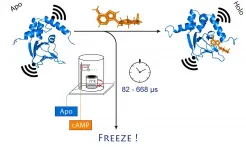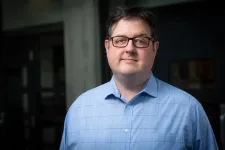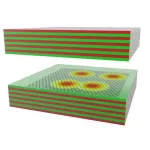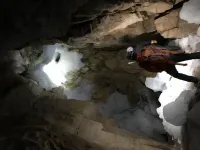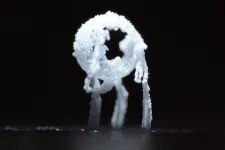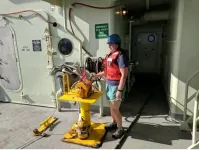(Press-News.org) Researchers at the University of Bonn and the research center caesar have succeeded in ultra-fast freezing proteins after a precisely defined period of time. They were able to follow structural changes on the microsecond time scale and with sub-nanometer precision. Owing to its high spatial and temporal resolution, the method allows tracking rapid structural changes in enzymes and nucleic acids. The results are published in the Journal of the American Chemical Society.
If you want to know what the spatial structure of a biomolecule looks like, you have a formidable arsenal of tools at your disposal. The most popular ones are electron microscopy and X-ray diffraction, which can reveal even the smallest details of a protein. However, a significant limitation of those methods is that they usually deliver static images, which are often insufficient to understand biomolecular processes in precise mechanistic terms. Therefore, a long-term goal of many research groups worldwide has been to track the movements within a macromolecule such as a protein over time while it carries out its work, just like in a movie. The research groups led by Prof. Dr. Olav Schiemann from the Institute of Physical and Theoretical Chemistry at the University of Bonn and Prof. Dr. Benjamin Kaupp from the research center caesar of the Max Planck Society have now come a step closer to achieving this goal.
They chose an ion channel for their investigation. This is a protein that forms miniscule pores in the cell membrane that are permeable to charged particles called ions. "This channel is normally closed," Schiemann explains. "It only opens when a cellular messenger, called cAMP, binds to it. We wanted to know how exactly this process works."
Mini magnets to measure distances
To do so, the researchers first mixed the channel protein and cAMP and then rapidly froze the solution. In the frozen state, the protein structure can now be analyzed. For their method to work, they had attached molecular electromagnets at two points in the channel. The distance between these magnets can be determined with a precision of a few Angstrom (ten billionths of a millimeter) using a sophisticated method called PELDOR, which works like a molecular ruler. In recent years, the method was significantly refined and improved in Schiemann's group.
"However, this only gives us a static image of cAMP binding to the ion channel," Schiemann says. "We therefore repeated the freezing process at different times after mixing the two molecules. This allowed reconstructing the movements in the protein after cAMP binding - just like a movie, which is also made up of a sequence of images."
At the center of this procedure is a sophisticated method that allows samples to be mixed and frozen very quickly at a precise point in time. The technique, called "microsecond freeze hyperquenching" (abbreviated MHQ), was originally developed at Delft University, but later fell into disuse. It was rediscovered and decisively refined by Kaupp's group.
"In the MHQ device, the cAMP molecule and the ion channel are mixed at ultrafast speed," Kaupp explains. "Then the mixture is shot as a hair-thin stream onto a very cold metal cylinder at -190 °C, which rotates 7,000 times per minute. It was particularly challenging to transfer the frozen samples for the PELDOR measurement from the metal plate into thin glass tubes, and to keep them frozen meanwhile. We had to design and build special tools for that."
Deep-freezing in 82 millionths of a second
The entire mixing and freezing process takes only 82 microseconds (one microsecond equals a millionth of a second). "This allows us to visualize very rapid changes in the spatial structure of proteins," explains Tobias Hett, one of the two doctoral students who contributed significantly to the success. The advantage of the method is its combination of high spatial and temporal resolution. "This represents a major step forward in studying dynamic processes in biomolecules," Kaupp emphasizes.
The researchers now plan to use their method to take a closer look at other biomolecules. They hope to gain new insights, for example into the functioning of enzymes and nucleic acids. The importance of such insights is best illustrated by the recent worldwide surge of structural research on the SARS coronavirus-2: The so-called spike protein of the virus also undergoes a structural change when human cells are infected. Clarifying this mechanism will provide valuable information how to target the infection mechanism with new drugs.
The preparation of the samples, the experimental execution, and the analysis of the data is very complex. The results of the study therefore also reflect a successful scientific cooperation with researchers led by Prof. Dr. Helmut Grubmüller of the Max Planck Institute for Biophysical Chemistry in Göttingen and Prof. Dr. Heinz-Jürgen Steinhoff of the University of Osnabrück.
INFORMATION:
Participating institutions and funding:
In addition to the research center caesar and the University of Bonn, the University of Osnabrück and the Max Planck Institute for Biophysical Chemistry in Göttingen were involved in the study. The work is funded by the German Research Foundation (DFG) within the framework of the Reinhart Koselleck Program and supported by funds from the Transdisciplinary Research Area "Building Blocks of Matter and Fundamental Interactions" at the University of Bonn, of which Prof. Schiemann is a member.
Publication: Tobias Hett et al.: Spatio-Temporal Resolution of Conformational Changes in Biomolecules by Combining Pulsed Electron-Electron Double Resonance Spectroscopy with Microsecond Freeze-Hyperquenching; Journal of the American Chemical Society; DOI: https://doi.org/10.1021/jacs.1c01081
Contact:
Prof. Dr. Ulrich Benjamin Kaupp
Emeritus Direktor, Forschungszentrum caesar
Tel. +49-228-9656100
E-Mail: U.B.Kaupp@caesar.de
Prof. Dr. Olav Schiemann
Institut für Physikalische und Theoretische Chemie
Universität Bonn
Tel. +49-228-732989
E-Mail: schiemann@pc.uni-bonn.de
Researchers have long noted that readers with dyslexia employ eye movements that are significantly different from non-dyslexics. While these movements have been studied in small sample sizes in the past, a new paper written by Concordia researchers and published in the Nature journal END ...
The ability to turn on and off a physical process with just one photon is a fundamental building block for quantum photonic technologies. Realizing this in a chip-scale architecture is important for scalability, which amplifies a breakthrough by City College of New York researchers led by physicist Vinod Menon. They've demonstrated for the first time the use of "Rydberg states" in solid state materials (previously shown in cold atom gases) to enhance nonlinear optical interactions to unprecedented levels in solid state systems. This feat is a first step towards realizing chip-scale scalable single photon switches.
In solid state systems, exciton-polaritons, half-light ...
Nearly one quarter of the land in the Northern Hemisphere, amounting to some 9 million square miles, is layered with permafrost -- soil, sediment, and rocks that are frozen solid for years at a time. Vast stretches of permafrost can be found in Alaska, Siberia, and the Canadian Arctic, where persistently freezing temperatures have kept carbon, in the form of decayed bits of plants and animals, locked in the ground.
Scientists estimate that more than 1,400 gigatons of carbon is trapped in the Earth's permafrost. As global temperatures climb, and permafrost thaws, this frozen reservoir could potentially escape into the ...
Chestnut Hill, Mass. (4/28/2021) -- The vast frozen terrain of Arctic permafrost thawed several times in North America within the past 1 million years when the world's climate was not much warmer than today, researchers from the United States and Canada report in today's edition of Science Advances.
Arctic permafrost contains twice as much carbon as the atmosphere. But the researchers found that the thawings -- which expel stores of carbon dioxide sequestered deep in frozen vegetation -- were not accompanied by increased levels of CO2 in the atmosphere. The surprising finding runs counter to predictions that as the planet ...
About a quarter of a percent of the entire gross domestic product of industrialized countries is estimated to be lost through a single technical issue: the fouling of heat exchanger surfaces by salts and other dissolved minerals. This fouling lowers the efficiency of multiple industrial processes and often requires expensive countermeasures such as water pretreatment. Now, findings from MIT could lead to a new way of reducing such fouling, and potentially even enable turning that deleterious process into a productive one that can yield saleable products.
The findings are the result of years of work by recent MIT graduates Samantha McBride PhD '20 and Henri-Louis Girard PhD '20 with professor of mechanical ...
Two teams have created a new generation of highly specific CAR T cells, which safely cleared solid tumors in mice with mesothelioma, ovarian cancer, and the deadly brain cancer glioblastoma while outlasting and outperforming conventional CAR T cell designs. The results suggest these cells could minimize the risk of dangerous side effects and address the traditionally poor performance of CAR T cells against solid tumors in the clinic. CAR T cells are genetically modified human T cells and have shown impressive performance in patients with leukemia. However, CAR T cells don't work as well against solid tumors, as these cancers lack molecular targets that the cells can easily recognize. ...
The number of distinctive sources and voices on the internet is proven to be in long-term decline, according to new research.
A paper entitled 'Evolution of diversity and dominance of companies in online activity' published in the PLOS ONE scientific journal has shown between 60 and 70 percent of all attention on key social media platforms in different market segments is focused towards just 10 popular domains.
In stark contrast, new competitors are struggling to survive against such dominant players, with just 3 percent of online domains born in 2015 still active today, compared to nearly 40 percent of those formed back in 2006.
The researchers say ...
The subseafloor constitutes one of the largest and most understudied ecosystems on Earth. While it is known that life survives deep down in the fluids, rocks, and sediments that make up the seafloor, scientists know very little about the conditions and energy needed to sustain that life.
An interdisciplinary research team, led from ASU and the Woods Hole Oceanographic Institution (WHOI), sought to learn more about this ecosystem and the microbes that exist in the subseafloor. The results of their findings were recently published in Science Advances, with ASU School of Earth and Space Exploration assistant professor and geobiologist ...
Organ development in plants mostly occurs through combinatorial activity of so-called meristems. Meristems are plant cells or tissues that give rise to new organs, similar to stem cells in human - including spikelets. Spikelets are components of the spike and form florets (flowers) themselves, which in turn produce grains after fertilisation.
Inflorescence morphogenesis in grasses (Poaceae) is complex and based on a specialised floral meristem, the spikelet meristem, from which all other floral organs arise and which also gives rise to the grain. The fate of the spikelet thus determines not only reproductive success, ...
DETROIT (April 28, 2021) - The results of a large, national heart attack study show that patients with a deadly complication known as cardiogenic shock survived at a significantly higher rate when treated with a protocol developed by cardiologists at Henry Ford Hospital in END ...
